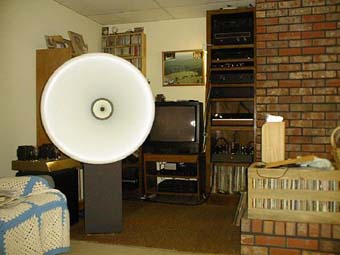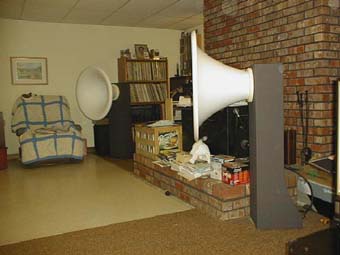Ralph Power, USA
I think Lowther's must have been designed for front horns as it TOTALLY transforms the sound character of the driver. All the "well known" peaks are vanished and replaced with a warm, beguiling sound that makes bad recordings quite listenable, and good recordings great. Mono has a depth and fullness previously undiscovered. Studio recordings of multi-track sound is presented in a very attractive, up-front manner without bunching or confusion. Live recordings have a presence that is just amazing. Large orchestras have great depth and power. And on and on ....It just plays more records better, it wins hands down over the back horns I had before.
In 1926, Paul Voigt, the designer of the Lowther driver, filed for a patent for a spherical front horn loudspeaker. A spherical horn launches a hemispherical wave front, which is phase and time consonant with the spherical wave fronts of musical instruments. The Lowther is a "full range" driver, designed for horn loading , thus avoiding the usual phase and frequency glitches of conventional electrical crossovers.

Most back horns and front horns, are rectangular shaped, launching artificially shaped, massively diffracted wave fronts that hamper the faithful reproduction of music. Also the folding of back horns into cabinets induces additional diffraction and turbulence problems with the wave front. Cabinet resonance's contribute additional problems. All of these problems are avoided by the simple, straight forward design of the spherical front horn. Ideally, a horn's surface should be perfectly smooth, particularly at the throat. The air pressure in this region is so high that any roughness here causes turbulence, which is then amplified as distortion. The molded ABS spherical horn of the Oris avoids this problem.
Horn drivers don't have to move much air and don't have to recover from large excursions, as do conventional drivers. Thus they have much lower distortion, unrivaled transient response and superb resolution of fine detail. In addition, they launch 90% of their energy toward the listening area, with much less out-of-phase spillover to excite room resonance's. But they are large and imposing and take some getting used to.
Upon first listening to the Oris's, you are immediately struck by the fact that the usual levels of grain and coloration are simply not present. You mind struggles to frame what is missing in a conventional manner, but has some difficulty. Eventually you realize that it is just the junk that is missing and what you are left with is the pure, "naked" sound of the music. You are also struck by the clarity of instruments and voices and the incredible dynamic range. Well recorded music breathes with the naturalness of the real thing and poorly recorded music sounds discontinuous to the degree to which it is flawed, but unfailingly musical at all times, with all recordings. Imaging is very good with more presence than I have ever experienced before. They have mated extremely well with my sub, much better than my back horns did.

I'm sure a lot of what I'm hearing has already been experienced by other front horn owners, but it's a new experience for me.
At this point I am elated with them and think they are a CONSIDERABLE improvement on the back horns that I had previously. I recommend them highly for those considering Lowther's, for those that already have Lowther's in conventional cabinets, and for those looking for a great speaker in general. As you can see, they are easy put together and a real alternative to back horns for a DIY Lowther project. IMHO, they are quite a value for the sound quality that they convey. I use a Radio Shack powered sub that goes up to 200hz and it works fantastic with it ! It has a remote volume control for dialing in just the right amount of bass.
I run my SE 6B4G amp full range into the Oris horns BTW. They are SUBLIME....